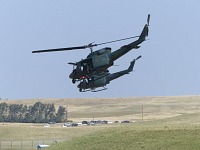 |
| Huey helicopters. |
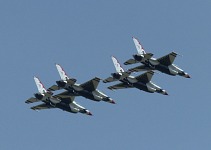 |
| Thunderbirds. |
At the end of July, Cheyenne holds Frontier Days — a week-long festival
of the Wild West — with countless rodeos, parades, concerts, dances, with
carousels and carnival attractions — and an Air Show. Lisa had been to
the carnival with Ian and then again with a whole youngsters' group (including
Tom, who discovered that he gets sick on a carousel — perhaps he finally
grew up?); we were mainly interested in the air show, said to feature The
Thunderbirds. We were not quite sure how it was supposed to work; according to
their website it seemed the affair was free of charge, and spectators were
supposed to watch from their parked cars. Thus we took a risk in dropping Lisa
off at her work (poor girl's shift fell right on the show time) and continued
to the Air Force base, where it all was to tak place.
Instructions described which gate spectators were to take, and mentioned the
fact that it would close at 0845 and no one may enter thereafter. Having thought
that by arriving shortly after eight there'd be sufficient time — we got
confronted with such a entrance demand, we spent subsequent thirty-five minutes
hopping in a line to the gate — and ours was the next to last car admitted
in. At least several hundred more lined behind us. So I think the organization
is not at all smart; cars have to slowly pass a narrow gate one by one, then
continue to rattle over an uneven dirt road onto a grassy hill. A huge
flag-lined parking was prepared there — certainly large enough to fit all
the remaining cars — if they only had the time to squeeze through the
only gate and narrow dirt road.
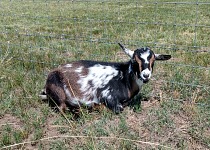 |
| Mick is a leisurely, deliberate goat; I place great expectations on him as the future leader of the herd. |
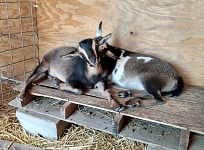 |
| Lori is such a baby and a fool. |
Well, there was a lesson for next time, we will need to set out earlier, take
our breakfast along, and stop hoping that being just an half hour early ensures
getting in. For sure, it's possible to watch the show from public roads around
the base, but best tricks, of course, are aimed at spectators inside, and
details won't be visible for behind a fence. Otherwise, the whole affair was
quite nice — rows of parked cars were separated by generous stripes of
grass, and whole families and individuals spread out blankets and camping
chairs, kiddies ran around and screamed in play, and everybody was happy.
Lisa's birthday at the end of July took place — the way she wished
— in a close circle. She visited the fair with Ian, got some presents
from use, mostly what she desired. Eventually the greatest ceremony happened
at her work. Women conspired, cooked a lunch, bought a cake and balloons, and
all sat down during a lunch break for a small party. I found it very nice of
them — Lisa had been working there for almost two months by then, and we
had certainly not expected them to celebrate a summer worker.
Our baby goats grew up a lot during summer; on first glance it is no longer
easy to distinguish Twilight from her babies. Licky's girls remain still a bit
smaller, Lori is likely to be a small goatie, a little fool for good. Having
grown up partially bottle-fed, she seems to consider me her mom — in the
sense that she feels I will forgive her absolutely everything. So when I need
to chase all the animals out of the shed, six goats and one chicken run out
— Lori and chickens Jet and Pepper rush to me — even when I wave
my arms and yell at them to get out.
Enya is a merry and cuddly goatie, our greatest goat pet. Bonnie grew up to be
a beauty, with a honey-shaded coat and eyes, looking very distinguished —
and deports herself like a princess — keeps a bit distant and has her own
ways. Mick is the largest of all baby goats and will likely still grow. I place
hopes onto him to replace Twilight as the alpha. He already show partriarchal
dignity and ages into a very reasonable and deliberate goat. Twilight is my
first goat and I like her (being perhaps the only one who does), but I must
admit that Twy is particularly crazy and inconsistent, so much that she
pointlessly harasses other goats (and people). Mick seems to grasp the
difference between leading others, and bullying. Freddy is kind of Mick's
side-kick. Despite being first-born, he is smaller and seems content with the
role of a younger brother. Like their sister Bonnie, he's a bit distant, but
when I insist, he lets me comb his coat and scratch him, and feed him treats.
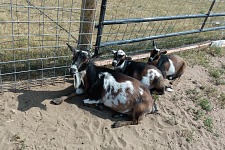 |
| Twilight, Freddy and Bonnie. |
 |
| Goaties have learned to trot out to the pasture on their own. |
Twilight worries me. She endured another episode of arthritis in summer —
this time so bad, she could not put weight on her leg, and hopped around on
three legs. It happened on one morning, when Lisa had a shift at the vet's,
and so I loaded Lisa and the goat and drove there. Normally one makes an
appointment — but it made no sense to drive Lisa out there, go back
home and called to get a slot — it seemed simpler to do it all at once.
Twilight got a short, and I could not milk her for three days (or rather
— I could milk, but we were told not to drink the milk) — and since
that moment I did not manage to re-start her dairy production, like I used to
in previous years. So we shall see ho fast the arthritis will advance.
Given the fact that I myself was diagnosed with the same problem, I can easily
imagine how this illness makes her life miserable. Therefore I am not sure, how
long I will be able to keep her, for I had experienced with Hazel, how
intervals between inflammations gradually shortened, until the creature
experiences more bad days than good ones. In any case, these were the last
babies Twilight would have — to load her with another pregnancy would
not be humane.
Another affair of the summer was a drone, which came to our family. That's
Sid's hobby, but it slightly improves how interesting our trips are. Like when
we thought in a more wooded part of Vedauwoo that we could
"hike around a pond" and then the drone has shown us clearly that
the pond was just one of many pools on a cascade of beaver dams, by which
the industrious rodent turned a whole valley with a creek into a chain of
small swamps that are really hard and long to hike around.
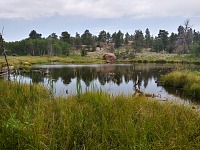 |
| We thought this pond would be easy to hike around. |
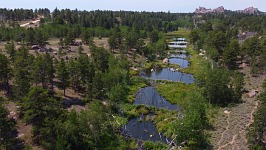 |
| A view from the drone revealed a cascade of beaver dams and impenetrable little swamps. |
Goat shack finally became electrified in August — so we don't span an
extension cord across the prairies. Along the electric cable, we had an
ethernet cable buried in the same trench — allowing to take the cameras
off wifi. Which, I hope, may improve the chance that my mobile phone works
again in the shack and on the pasture. Electrification has had an interesting
side effect on goats' education. Before we had a good fence, I used to take
the goats out on a leash and implored them to not run away. Goats took it heart
— and then, even with a fence around their pasture, they would not walk
out alone, somebody had to take them.
When it came to digging the trench and installing electrics in the shed, it
was necessary to prevent them from assisting too closely — so I locked
them out on the pasture, and they had no way to get "home". They were
wondering about it on the first day, but but on the second day they marched out
to the pasture without being told. Since then they go out to graze without our
attendance, and that is a great relief — and represents savings in hay.
We finished our summer in a ballooning fashion. When we discovered an event
roster in a Cheyenne's Ballooning Club newsletter, and on it a ballooning
rally in Hot Springs, South Dakota — the place which Lisa refused to
leave at one time, she liked it so much — I did not hesitatee and wrote
to Petra, the local organizer, that we would like to stop by. Petra knows
Jeanne, who had mentioned earlier that Petra was actually a Czech as well,
so we had already exchanged a few emails in spring. Now we took advantage of
it, reserved a hotel room, and announced we would attend, and if she finds
us a pilot without a crew, we would be happy to help.
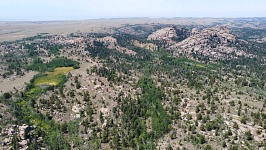 |
| Vedauwoo. |
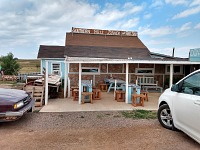 |
| Southern Hills Diner — we're in a neighboring Dakota, having excellent breakfast. |
Lisa announced that she did not want to go, having to serve a shift on Friday,
and we left her behind with a heap of instructions. We actually dropped her off
on Friday noon at work, and she had arranged for Ian to take her back home
— while the rest of us continued north to Dakota. It's actually just a
stone's throw, shorter than we used to have from Bay Area to Leavitt Meadows
— around four hours. We checked in and went to a dinner at Wooly's.
Petra called us then, inviting us to a local community center where a
ballooning get-together was taking place; to introduce us to our pilot,
John. We finished dinner and went to meet John.
We set our alarm clock to 4:45, which is no fun, but actual sleeping at the
hotel was much worse. We're apparently quite spoiled by out little house on
the prairie, where coyotes sometimes howl, but otherwise we sleep in peace
and darkness. Despite our property bordering on a county road, the locals are
of the working kind — nobody drives much through the night, everybody
rests before the morning shift. And here we were in a hotel in a tourist area,
on Friday night, with people arriving until very late hours. Further, street
lamps, spotlights illuminating the very hotel, the rattle of the elevator,
air-conditioning, bathrooms fans, doors slamming, chatter along the corridors
— and Sid's snoring. I managed to fall asleep by one-thirty in the
morning — and could not sleep past three-thirty. Tom did not fare much
better.
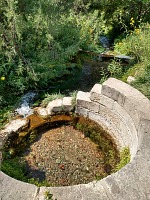 |
| Spring. |
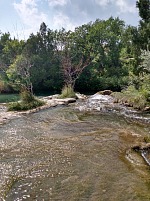 |
| Cascade at Cascade Creek. |
By five thirty, we reached the airport, but not very optimal form — yet
the launch got canceled in the end, for not only was there too much wind
— but it blew away across a lake, where it would be hard to chase the
balloons. So we went back to the hotel to sleep it off, and before noon we
quizzed the hotel owner, where to have a local dinner, and where to find
something interesting. Hot Springs are a small town, heavily occupied by
tourists, who generally head north to national parks — and to Mt.
Rushmore. Hot Springs proper contains a museum with mammoth excavations
— a local historic mud-hole was a spot where tens of these large animals
got trapped and drowned, and new are being discovered. One would expect that
such a place offers a whole array of accommodations, restaurants and tourist
services — instead it's a veritable One-Pub-Town, compelling visitors to
move on. Only two restaurants open on Saturday — Woolly's and a pizzeria.
We dined at the former the previous night, and basically sampled their whole
menu (a steak and a burger); with my gluten intolerance, I can hardly enjoy
a pizzeria.
Our hotelier recommended Southern Hills Diner, noting that we should not get
detracted by its looks. A very sound advice, for not knowing about this local
gem, we would have passed this inconspicuous blue ranch house — and even
having noticed it, we would not have expected to receive great food there. It's
a typical American "Mom and Pop" business. A family affair, where
everybody lends a hand — and where everything is being cooked from basic
ingredients. Your omelet will show it's made from actual eggs (it's not poured
into the pan from a can), quiche was apparently also home-made, and not
defrosted from a wholesale box, and so on.
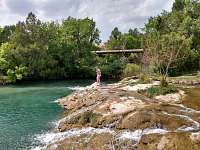 |
| A blue pool is barely 68 degrees, but the water is great. |
 |
| Vacation. |
Entertained and refreshed, we drove on toward Cascade Creek. This stream is
special in that it starts as a warm spring. But don't picture something like
steaming and fuming Yellowstone. A warm spring consists of having 66.6°F
— but throughout the year, so it does not freeze in winter, and thus
rare plants grow there, which need a stable temperature.
First we stopped at Cascade Springs — the spring proper. They used to be
a commercial exploit, and are nicely civilized, surrounded by rocks and little
walls. Water is incredibly clear, it's hard to estimate how deep it actually is
— and then you're surprised that you slide in waist-deep. Wild apples and
wine grows around, and I tasted its great fruit (which Tom and Sid refuse to
touch because it's sour).
Our next stop, somewhat downstream, was Cascade Falls. The creek runs across
rocky steps and forms several pools — ending in a large one, wide and
deep enough for swimming. It's not only possible — it's necessary.
I don't know how deep it is, but one can't reach the bottom, despite it looking
close. Again only I went in, and swam around and splashed and discovered. Tom
took pictures from the shore and Sid flew his drone. Those 68 degrees is a
good swimming temperature, not chilly at all (and I think the bottom pool was
heated by sun and much warmer than upstream springs).
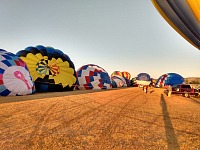 |
| Launch. |
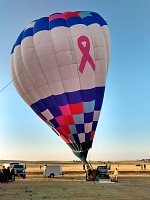 |
| Wind did not let the balloons inflate properly, and take-offs were somewhat dramatic. |
Alas, relying on hotel owner's advice failed us, in third instance. We had
asked where to find a hiking trail somewhere near. Naturally, we were capable
of perusing maps of nearby state and national parks and find something, but on
one hand these were located relatively far from Hot Springs, and on the other
hand are continuously packed by tourists. We had hard time finding a parking
spot in Needles the previous year, and it seemed to us like a waste of time.
Yet we had probably run into being spoiled from the West Coast, with a really
great number of public natural areas, with trails and routes. South Dakota,
it seems, operates more in the Eastern style — most land is private,
and public parks are over-crowded.
We had found the recommended Mickelson Trail, but to our dismay it turned out
to be a biking trail built on top of a historic railroad track —
spanning original train bridges and tunnels — which may be interesting
to experienced on a bicycle, but for a hiker is a sand-surfaced road, which
mostly runs right next to a busy county road, rather unattractive. We tried
to drive into the National Forest area, whose status we associate with lots
of natural trails and camping sites — and did not succeed here either.
It consisted of impenetrable forest — or else it was filled by fenced-off
lots with weekend houses. We had to congratulate ourselves to choosing our new
home — as much Hot Springs and Black Hills are located in a beautiful
landscape, it's not the right one for our lifestyle. In reality, one is either
permitted to visit an over-crowded national park, or reduced to live in
a forgotten small town with the only pub open only few days of week —
with really limited choices for trips out.
We returned back to our hotel, boys went out to have dinner in the pizzeria,
and I lied down for an hour. I managed to sleep for about an hour and half at
night, and for forty minutes in the morning — and started to feel quite
impossible. Our next call of duty came at seven in the evening in the city
park, where the balloonists made a stationary light show for the public —
and needed crew to build the balloon and pack it back again. And because
burners heating the balloons look best when they illuminate insides of the
balloon envelopes after dark, we got to wait till dusk — and got back
to bed again by ten — with alarm set to 4:45.
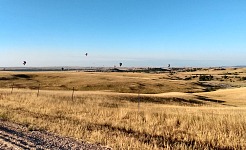 |
| In contrast, landings were very poetic and serene. |
 |
| Packing. |
Petra begged us to split up for Sunday crewing — two people with John
and one for a pilot no crew at all. We offered Sid — Tom and I stayed
with John, his wise, and two more friends — and we had delegated our
hippo powers elsewhere. To our great surprise, Sunday morning turned out to
be flyable. When I watched balloons swerving in gusts of wind, and when we
experienced a relatively dramatic take-off, with every able body hanging on to
the basket, hoping that the wind won't spill the pilot out and that he would
hit the moving target of the envelope's throat with his burner — and then
watched balloons speed off north after take-off — I did not believe
it would end well. Here it turned out I did not know local circumstances. The
hardets part of any (balloon included) flying is LANDING. To find a spot devoid
of power-lines, poles, buildings, fields with ripening crops, trees —
instead, a spot with road open for a column of helpers to collapse and load
the ballooon (the whole circus weighs close to four hundred pounds, and that's
not something one can lift easily). Finding such a place in a populated
landscape is frequently a problem. No so much near Hot Springs. Grassy prairie
ranches spread north of the town, with roads — and collapsible sections
in fences that allow pick-up trucks to roll onto a pasture. Local balloonists
have an understanding with ranchers that landings are OK on their property.
However dramatic the take-offs were, landings were simple and safe.
On our way from the landing place and packing our balloon, we spotted Sid
— thus avoiding the problem with finding him among hundreds of crews
— and after a quick shower at our hotel, we set out for home.
Got back by two in the afternoon, and had enough time to nap, unpack, do
laundry, and have a dinner out with Ian and Lisa. It was our thank you to Ian
for chaffering Lisa around while we were gone; we took our daughter back
and hurried home — to sleep some more.






















